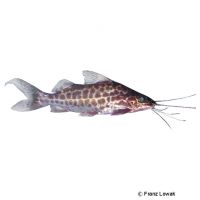Spotted Pim (Pimelodus maculatus)
| Spotted Pim Pimelodus maculatus | |
|---|---|
| Name | Spotted Pim |
| Name Lat. | Pimelodus maculatus |
| Family | Long-whiskered Catfishes |
| Family lat. | Pimelodidae |
| Order | Catfishes |
| Order lat. | Siluriformes |
| Origin | South America |
| Habitat | Rivers |
| Diet | Carnivore |
| pH | 6.5-7.5 |
| Behavior | Predatory |
| Keeping | Individual, group |
| Care Level | Moderate |
| Reproduction | Egg scatterer |
| Breeding | None reported |
| Life Span | 5-10 years |
| Protection | No |
| Metric Units | |
| Size | 18-23 cm |
| Temperature | 20-24 °C |
| Hardness | 5-15 °dH |
| Aquarium | 350 l |
| US Units | |
| Size | 7"-9" |
| Temperature | 68-75 °F |
| Hardness | 89-267 ppm |
| Aquarium | 90 gal |
Distribution and habitat
The crepuscular to nocturnal Spotted Antenna Catfish are widespread in the catchment area of the Rio Sao Francisco and Rio Parana in Brazil and Argentina. There they live in shallow, slow-flowing waters with sandy-muddy bottoms, where they usually stay hidden under roots or in stone caves during the day.
Maintenance
The aquarium should have a robust border planting, with many hiding places such as stone caves (e.g. hole rock) and roots, as well as plenty of free swimming space. A soft, sandy substrate, some subdued light (floating plants) and a weak current is ideal. No ammonia, ammonium and nitrite should be detectable, the nitrate value should not exceed 100 mg/l. To ensure the water quality and oxygen content, a filter and heater adapted to the aquarium size is required, as well as lighting for the species-appropriate day-night rhythm of the animals.
Diet
The food supply consists of live or frozen mosquito larvae, tubifex, shrimp, earthworms, etc. or a vitamin-enriched frozen food mix. Sinking, protein-rich dry food for catfish, such as pellets, granulate and tablet food is also well accepted
Only feed as much as will be eaten within a few minutes, and adult animals should only be fed 2-3 times per week. Regular and varied feeding promotes health and increases resistance.
Behaviour and compatibility
It is recommended to keep these peaceful and mutually compatible fish in a group of 3-5 animals. Keeping a group is only possible in a much larger and richly structured aquarium. They can be well socialized with larger, active fish. Fish that are too small are considered food.
Basically, only compatible fish species with similar requirements for water quality and water temperature should be socialized.
Sex dimorphism
There are no known external distinguishing characteristics.
Reproduction and breeding
There are no known reports of successful breeding in the aquarium.
Important
Their coloration and pattern may vary according to their origin.
During the acclimation period it is recommended to feed these mostly crepuscular and nocturnal animals at night. They are voracious eaters, accordingly food breaks should be taken or only small portions fed
The swimming space must be dimensioned so that the fish can move freely and its long barbels (antennae) do not bump anywhere. A weekly partial water change is strongly recommended, as they are very sensitive to pollutants in the water and may lose their barbels as a result.
When catching them, use fine-mesh nets if possible; transparent cups are better so that the poisonous hard rays (with barbs) of the pectoral and dorsal fins do not get caught, which can cause painful stinging injuries when touched. The venom is equivalent to that of a bee sting.
The well-being of the fish should be checked regularly. Temperature should be checked daily, pH, hardness and nitrate levels at least every 14 days. Regular partial water changes are recommended, even if the contaminant level has not yet reached the upper limit. Sudden changes in water quality should be avoided. Newly introduced fish must be accustomed slowly to the water in the aquarium.
Further literature can be found in your pet store.
References
Text: Werner Winter; Image: Franz Lowak
Source: BMELV (1998): Tierschutzgutachten - Haltung von Zierfischen (Süßwasser); BAENSCH & RIEHL (2004): Aquarien Atlas Bd. 2, Mergus Verlag; ENGELMANN (2005): Zootierhaltung - Tiere in menschlicher Obhut: Fische, Verlag Harri Deutsch
- Gemäß § 21 Abs. 5 Tierschutzgesetz idgF
